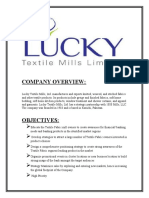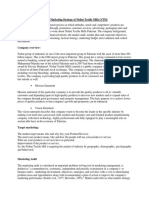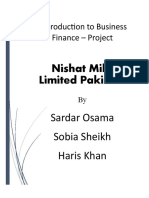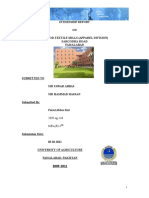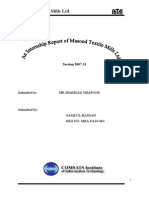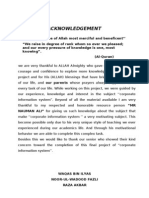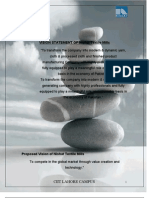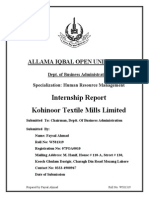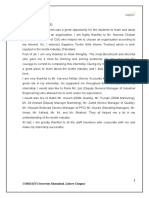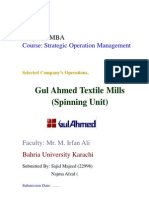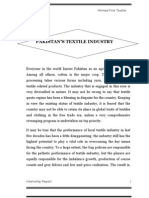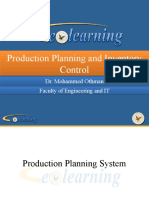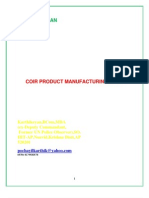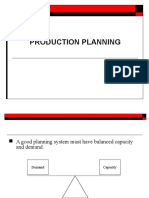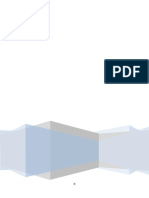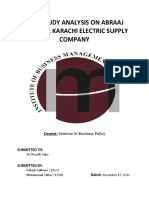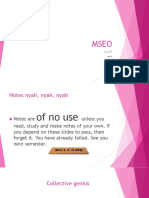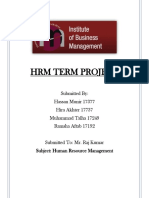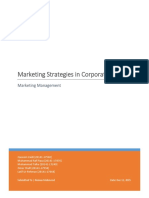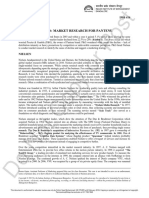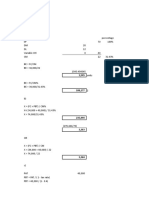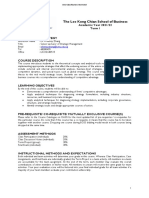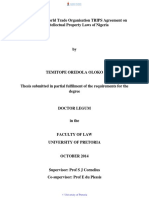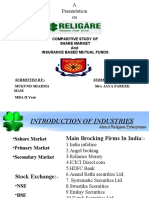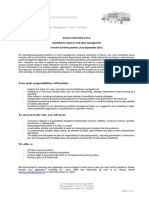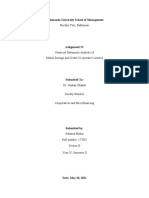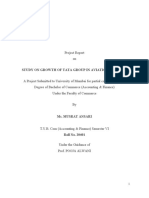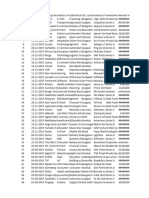Lucky Textile Mills Limited
Production & Operation Management || Project Report
Muhammad Rafi Raza [20141-17876]
Qaseem Zaidi [20141-17560]
Muhammad Talha [20141-17249]
Umair Saleem [20141-17619]
Submitted To | Mukhtar Ahmed
Date: Dec 12, 2015
�Table of Contents
INTRODUCTION ............................................................................................................................................. 3
VISSION ......................................................................................................................................................... 3
MISSION ........................................................................................................................................................ 3
PRODUCTS..................................................................................................................................................... 3
LOCATION...................................................................................................................................................... 4
SUPPLY CHAIN OF LUCKY TEXTILE ................................................................................................................. 4
CAPACITY AND PRODUCTION PLANNING ................................................................................................. 4
Level 1 - Business Plan .......................................................................................................................... 5
Level 2 Sales and Operational Plan (SnOP) ........................................................................................ 5
Level 3 Master Production Schedule ................................................................................................. 6
Level 4 Material Requirement Planning ............................................................................................. 8
Level 5 Production Activity Control.................................................................................................... 9
Goals of Capacity & Production Planning ........................................................................................... 10
INVENTORY & STORES............................................................................................................................. 12
Goals of Inventory Management ........................................................................................................ 13
PURCHASE AND PROCUREMENT ............................................................................................................ 14
Sources ................................................................................................................................................ 14
Raw Materials ..................................................................................................................................... 14
Goals of Procurement ......................................................................................................................... 15
LOGISTICS (Transportation, Warehousing and Packaging) ..................................................................... 16
Goals of Logistics ................................................................................................................................. 16
�INTRODUCTION
Lucky Textile Mills was first established in 1983 and has since remained one of the leading textile
manufacturers in the country to-date. With an indelible commitment to employing the most
modern technology and providing outstanding working conditions for all staff, have always
believed in creating the best value for any entity that invests its time with company. For over 25
years, continued focal point has remained on its esteemed customers and their satisfaction,
which it always strives to guarantee.
With 3 state-of-the-art weaving mills that house 750 Sulzer Shuttle-less looms which are
equipped with computerized back process comprising of Karlmayer warping and sizing machines.
This high-tech mechanism is installed to cater to the international market and has a capacity to
process 250, 000 meters per day and over 83 million meters / annum processing capacity. Also,
our factories facilitate over 6.20 MW of power generation that provides a self-sufficient energy
source.
We maintain that every aspect of our operations is inclined towards adding to a progressive
future and firmly believe that by stringently pursuing our core values of Leadership,
Understanding, Commitment, Knowledge and Yielding, we will undoubtedly grow to be one of
the most successful industry leaders in the country. Lucky textile mills is a part of Lucky group,
they are renowned for their textile products.
VISSION
To be the undisputed leader in the textile industry whilst providing a socially responsible
commitment to the environments we invest in.
MISSION
Provide unrivalled quality and assurance to all our customers and stakeholders by employing
techniques that serve both our internal and external environments with respect and integrity
PRODUCTS
Lucky Textile creates products that are contemporary and pure. Our trendy and classic products
are a blend of our cutting edge technology and highly skilled craftsmanship that charm the buyers
across the globe. Our Products include,
1.
2.
3.
4.
5.
Finished Fabrics
Soft Home Bedding
Soft Home Kitchen
Window Treatment & Shower Curtains
Apparel & Garments
�LOCATION
The lucky textile mill is located in the ideal location in the view of effective supply chain. The main
head office and factory L-8, Block-21, F.B.Area, Karachi 75950, Sindh, Pakistan and second factory
is at A - 8/C S.I.T.E -, Karachi.
SUPPLY CHAIN OF LUCKY TEXTILE
Supply chain management includes all the activities related to suppliers, distributors, retailers,
warehousing and delivery that maximized value to the customers. LTML possess a systemic
approach towards managing a strong supply chain. We will discuss about following elements of
supply chain of LTML which includes:
Purchase procurement
Warehousing and distribution
Logistics
Scheduling
Supply chain strategies
Benefits of supply chain management for Lucky Textile
Following are the major functions of LTML supply chain department,
1.
2.
3.
4.
Capacity and Production Planning
Inventory and Stores
Procurement
Logistics
CAPACITY AND PRODUCTION PLANNING
Manufacturing is complex. Some firms make a few different products, whereas others make many
products. However, each uses a variety of processes, machinery, equipment, labor skills, and material. To
be profitable, a firm must organize all these factors to make the right goods at the right time at top quality
and do so as economically as possible.
It is a complex problem, and it is essential to have a good capacity and production planning system. A
good planning system must answer four questions:
What are we going to make?
When are we going to make?
What do we have to make it?
What do we need to make it?
These are questions of priority and capacity.
�Priority
It relates to what products are needed, how many are needed, and when they are needed. The delivery
requirement of the customer who has placed the order is the source of establishing the priorities.
Capacity
It is the capability of manufacturing to produce goods and services. Eventually it depends on the resources
of the company the machinery, labor, and financial resources, and the availability of material from
suppliers. In the short run, capacity is the quantity of work that labor and equipment can perform in a
given period.
There are five major levels in Capacity & Production Planning:
Business Plan
Sales and operations plan
Master Production Schedule
Material Requirement Plan
Production Activity Control
Level 1 - Business Plan
The business plan is a document of the major goals and objectives the company expects to achieve over
the next 3 to 10 years or more. It is a statement of the broad direction of the firm and shows the kind of
business product lines, markets, and so on the firm wants to do in the future. The plan gives general
direction about how the company hopes to achieve these objectives. It includes participation from
Marketing, Finance and Production.
Marketing is responsible for analyzing the marketplace and deciding the firms response: the
markets to be served, the products supplied, desired levels of customer service, pricing strategies
and so on. It is also responsible for research, development, and design of new product or
modifications to existing ones.
Finance is responsible for deciding the sources and uses of funds available to the firm, cash flows,
profits, Return on investment and budgets.
Production must satisfy the demands of the marketplace. It does so by using plants, machinery,
equipment, labor, and materials as efficiently as possible.
Level 2 Sales and Operational Plan (SnOP)
After the objectives are set by the business plan, the management is concerned with the following:
1.
2.
3.
4.
The quantities of each product group that must be produced in each period
The desired inventory levels
The resources of equipment, labor, and material needed in each period
The availability of the resources needed
�The level of detail is not high as only the aggregate demand of a product is planned for production. The
plan must meet deadlines within the resources available to the company.
This process of determining the resources required and comparing them to the available resources takes
place at each of the planning levels and is the problem of capacity management. For effective planning,
there must be a balance between priority and capacity.
The planning horizon should be 6 to 12 months and is reviewed each month in the SnOP meeting.
SnOP Plan
Level 3 Master Production Schedule
The master production schedule (MPS) is a plan for the production of individual end items. It breaks down
the production plan to show, for each period, the quantity of each end item to be made.
For example, at weaving stage the MPS for each fabric quality will be separate showing weekly fabric
production against the aggregate weekly fabric requirement, regardless of customer and relevant user.
The planning horizon should extend from 3 to 6 months.
Yarn MPS
�Weaving MPS
Processing MPS
�Level 4 Material Requirement Planning
The material requirements plan (MRP) is actually the planning of the input to the MPS. MRP is a plan for
the production and purchase of the components or material used in making the items in the MPS. It shows
the quantities of material needed and when manufacturing intends to make or use them. The level of
detail is high.
For example the MRP for weaving a specific fabric quality will consist of planning of required number of
looms, quantity of size beams required, the warping production required for achieving that sizing
production and the relevant yarn requirement.
It should at least extend to a period of 3 months.
YARN MRP
�Weaving MRP
Level 5 Production Activity Control
Production Activity Control (PAC) represents the implementation and control phase of the MRP. PAC is
responsible for planning and controlling the flow of work through the factory. It includes,
Daily production reports
Break down reports
Efficiency reports
Quality reports etc.
The planning horizon is very short, perhaps from a day to a month. The level of detail is highest since it is
concerned with individual machines, workstations, and orders. Plans are reviewed and revised daily.
Goals of Capacity & Production Planning
Goals of capacity and production planning can be comprised into three categories,
1. Short Term Goals
2. Mid Term Goals
3. Long Term Goals
Short Term Goals
Identify capacity at weaving & processing
Identify process lead-times with coordination of production units
Planning Demand Convert sales dollars into units, processes and fabrication
Planning Supply Identify inventory stocks, production rates & procurement schedules
Mid Term Goals
Aggregated Demand Confirmed Orders, Projections and Estimates
Master Production Schedule Prepare schedule of order fulfillment based on production and
shipment timelines
Material Requirement Planning Plan material production or purchasing at department levels.
Confirmed Orders & Projections
Yarn
Total
Feb16
Mar- Apr16
16
MayJun-16 Requirement
16
Sales Contract 1 400
200
1200 400
200
1200 3600
Sales Contract 2 800
600
300
600
300
Jan-16
30/s cotton
carded
Aggregate
Demand
Sub total
1200 800
800
1500 1200 800
3400
1500 7000
�30/s pc carded
Sales Contract 1 400
200
1200 400
200
1200 3600
Sales Contract 2 800
600
300
600
300
Sub total
1200 800
800
3400
1500 1200 800
1500 7000
40/s cotton
combed
Sales Contract 1 400
200
1200 400
200
1200 3600
Sales Contract 2 800
600
300
600
300
800
Sub total
1200 800
1500 1200 800
Total Demand
3600 2400 4500 3600 2400
3400
1500 7000
4500 21000
Aggregated Demand 1
Lead times
30 days
Step 02: Master Production
Schedule
45 days
60 days
90 days
Week Week Week Week Week Week Week Week Week Week Week Week
1
2
3
4
5
6
7
8
9
10
11
12
Weeks
Projections
100
Confirmed
30/s pc 52:48
Orders
carded R/S
Total
Requirement
Inventory on
hand
40
100
100
200
200
200
200
200
200
200
200
200
200
200
200
200
200
300
100
100
200
200
200
200
200
440
640
440
240
440
140
40
340
140
340
140
-60
�Order
scheduled
receipt
400
400
Balance
Inventory
240
440
240
Weeks of
Supply
1.2
2.2
1.2
400
400
400
40
140
40
-60
140
-60
140
-60
-260
0.1
1.4
0.4
(0.3) 0.7
(0.3) 0.7
(0.3)
Master Production Schedule 1
Lead Time 1
Long Term Goals
1. Capacity Planning based on Business Plan
2. Orders TNA for visibility
3. Planning Zones (Time fences),
Frozen zone (no change)
Slushy zone (20% change)
Liquid zone (100% change)
INVENTORY & STORES
Lucky Textile Mills Limited (LTML) aims to establish an improved internal systematic environment for
which they have created a new SUPPLY CHAIN DEPARTMENT. The major part of this department is the
Inventory Control Unit. LTML has total value of around Rs.12 billion of which Rs.3 billion are blocked in
stock which is relatively high. Inventory control unit would be helping in organizing the stores, minimizing
the increasing stock level and sort out excessive inventory from the stores.
Amount in PKR
15,000,000,000
12,000,000,000
10,000,000,000
5,000,000,000
3,000,000,000
0
Stocks value
Total Company value
�Goals of Inventory Management
Short Term Goals
Centralized Item Codes
We analyzed the item coding procedures of the stores of all the units and decided to centralize
the item coding opening format which is proposed by me with consensus of IT department in
order to avoid item duplication and wrong description of items.
The first goal of the inventory control unit is to improve the item coding. By improving item coding
system it would be more convenient to categorize and find the inventory stock. It will be
minimizing the loss of stock and its excessive consumption.
Mid Term Goals
Excess Inventory
The second goal of the inventory control unit is to control the storage of excess inventory in the
store. The excess inventory also includes the slow moving goods and dead inventory. It has to be
discussed with the management either to utilize or dispose of the following dead inventories.
Long Term Goals
Critical Items
Third goal of the inventory control unit is to define critical items. Those items which are critically
consumed by the production unit must be updated. A planning must be done in order to create a
better coordination between store and production unit.
Stock Level
The final goal is to decrease the stock level to an appropriate level. The stock level of the company
is relatively very high and need to be minimized to a certain level. Inventory control unit is looking
forward to plan and sort out the stock level in future.
�PURCHASE AND PROCUREMENT
The planning of purchasing the raw material of Lucky textile Mill is outstanding, the threat of
bargaining power of suppliers in not a case for them. The Major raw material suppliers are Fazal
textile mill and Gadoon textile Mills which are the companies of same group. The detail of both
the sources and their item which are supply to Lucky textile are;
Sources
Fazal Textile Mills Limited
Fazal Textile is a spinning mill with over 65,000 installed spindles that
produce 100% Grey cotton ring spun yarn and a wide range of
Blended and Heather yarns.
Gadoon Textile Mills Limited
The first of only two mills in the world which started producing
compact core spun yarn, the Gadoon Textile Mills house 194,392
installed spindles producing high quality compact yarn, murata jet
spinning yarn, core spun yarn and 100% Grey cotton ring spun yarn.
Raw Materials
COTTON RING SPUN CARDED YARN FOR KNITTING AND WEAVING
Count range from NE 6/1 to NE 32/1
COTTON RING SPUN COMBED YARN FOR KNITTING AND WEAVING
count range from NE 16/1 to NE 40/1
HEATHER ( MELANGE ) YARN WITH DYED PORTION OF POLYESTER
Count range from NE 10/1 to NE 40/1
POLY/COTTON YARN IN CARDED AND COMBED FOR KNITTING AND WEAVING
Count range from NE 16/1 to NE 60/1
CVC YARNS IN CARDED & COMBED FOR KNITTING & WEAVING.
Count range from NE 16/1 to NE 60/1
COTTON COMPACT SPUN COMBED YARNS FOR HIGH QUALITY KNITTING AND
WEAVING. Count range from NE 20/1 to NE 140/1.
POLYESTER MURATA JET SPINNING ( MJS) CARDED YARN FOR KNITTING &
WEAVING From NE 10/1 to NE 30/1
POLY / COTTON MURATA JET SPINNING ( MJS) CARDED YARN FOR KNITTING &
WEAVING From NE 10/1 to NE 30/1
RING CORE SPUN YARN IN CARDED AND COMBED FOR KNITTING & WEAVING
Count range from NE 7/1 to NE 30/1
COMPACT CORE SPUN YARN IN COMBED FOR KNITTING & WEAVING.
Count range from NE 30/1 to NE 80/1
�Goals of Procurement
Analyze all the procurement procedures working at LTML
Adopt and implement best practices of procurement
Reevaluate the present systems for purchasing from procurement point of view
Design a Centralize Procurement System with help of IT for optimizing costs and implementing
controls in a better way
Implementing of supplier pre-qualification system and maintain their data on the basis of their
approved or un-approved status
Formulate a Quarterly Evaluation System for the suppliers
Initiate a Supplier Relationship Management Initiative and develop relations for increased
collaboration and supply availability
Implement the concept of Total Cost of Ownership
�LOGISTICS (Transportation, Warehousing and Packaging)
Goals of Logistics
Short Term Goals
Centralize transportation activities through implementation of Transportation Management
System (TMS)
Advantages of Transportation Management System:
Enhanced freight audit capabilities
Lower transportation costs through shipment consolidation and load building
Automated Routing and shipment tracking
Improve on-time delivery performance
Implement inventory visibility through bar coding technology
Advantages of item bar coding
Error reduction
Inventory control
Time saving
Inventory count accuracy
Mid Term Goals
Implement Warehouse Management System (WMS)
Implementing monthly or quarterly inventory count for reconciliation purpose
Review warehousing capacity and future capacity requirements
Review the product packaging needs and procedures of the company

